Pediatric Neuropathology & Neurodevelopmental Disorders
Oral
Neuro
Wednesday, 20 June 2018
| W03/04 |
13:45 - 15:45 |
Moderators: Nadine Girard, Sean Deoni |
13:45
|
0843.
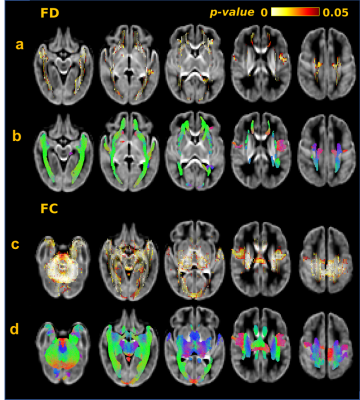 |
 Fixel-based analysis of white matter fibre density and morphology in the preterm brain. Fixel-based analysis of white matter fibre density and morphology in the preterm brain.
Diliana Pecheva, Jacques-Donald Tournier, Maximilian Pietsch, Daan Christiaens, Dafnis Batalle, Daniel Alexander, Mary Rutherford, Joseph Hajnal, A. Edwards, Hui Zhang, Serena Counsell
Fixel-based analysis (FBA) provides measures of fibre cross-section (FC) and fibre density (FD) for individual fibre populations within voxels containing crossing fibres, overcoming the limitations of the diffusion tensor model. FBA was applied to a preterm neonatal cohort to assess the effects of perinatal risk factors on white matter, identifying decreases in FD and FC in distinct fibre populations associated with increased prematurity, low birthweight, respiratory support and parenteral nutrition. We show that aberrant white matter development previously attributed to microstructural changes may be related to alterations in the cross-sectional area of specific fibre bundles at the macroscopic scale.
|
13:57
|
0844.
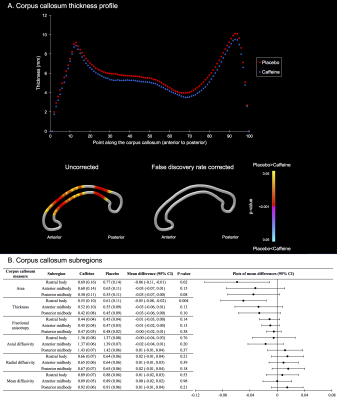 |
 Caffeine and brain development in preterm children Caffeine and brain development in preterm children
Claire Kelly, Wenn Lynn Ooi, Joseph Yang, Jian Chen, Chris Adamson, Katherine Lee, Jeanie Cheong, Peter Anderson, Lex Doyle, Deanne Thompson
We investigated effects of neonatal caffeine treatment on brain structure and longitudinal development in a subset of preterm children from a randomized, placebo-controlled trial. Children had MRI at age 11 years (n=118; 64 received caffeine, 54 received placebo), of whom 43 (21 caffeine, 22 placebo) had MRI at term-equivalent age. Global and regional brain volumes, cortical morphometry and white matter microstructure were similar between treatment groups at age 11 years, as was brain development from term-equivalent age to 11 years of age. Any benefits of caffeine on brain structure weaken over time and were not apparent at age 11 years.
|
14:09
|
0845.
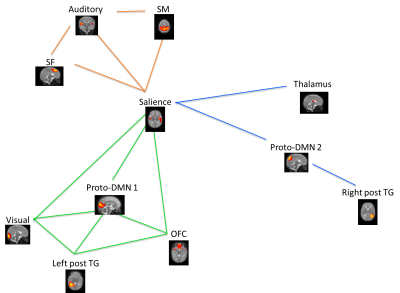 |
 Early postnatal music intervention in preterm birth reorganizes salience network interactions Early postnatal music intervention in preterm birth reorganizes salience network interactions
Djalel-Eddine Meskaldji, Lara Lordier, Frédéric Grouiller, Marie P. Pittet, Lana Vasung, François Lazeyras, Didier Grandjean, Dimitri Van De Ville, Petra S Hüppi
The aim of this study is to characterize the preterm brain functional connectivity and to test the effectiveness of an early postnatal music intervention on preterm newborn’s functional brain development. We explored functional connectivity by resting state fMRI in 16 full-term 1 to 4 days old newborns and 29 preterm infants (born < 32weeks) at term equivalent age (TEA) randomly assigned to either music intervention (14 newborns) or control group. We identified a network of interest that represents resting state functional connectivity decrease in preterm control compared to full-term newborns. We found salience network functional connectivity to be especially altered by a premature birth but music intervention significantly increased its connectivity. To the best of our knowledge, this study is the first one to observe music effects on brain development in the preterm newborns.
|
14:21
 |
0846.
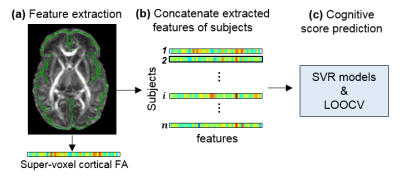 |
 Cortical microstructures at birth predict neurodevelopmental outcome at 2 years of age Cortical microstructures at birth predict neurodevelopmental outcome at 2 years of age
Minhui Ouyang, Qinmu Peng, Michelle Slinger, Hao Huang
Cortical microstructural architecture in preterm brain, quantitatively delineated with DTI fractional anisotropy (FA), is characterized by various levels of dendritic arborization. With cortical FA an important indicator of cortical maturational level, we hypothesized that cortical FA at birth predicts neurodevelopmental outcome at 2 years of age. We used FA across cortical regions of neonate brains to predict their Bayley scores at 2 years of age with machine learning algorithms. A highly predictive model was achieved with inhomogeneous pattern across cortical areas. Significant correlation was found between FA values in widespread cortical regions at birth and cognitive scores at 2 years.
|
14:33
|
0847.
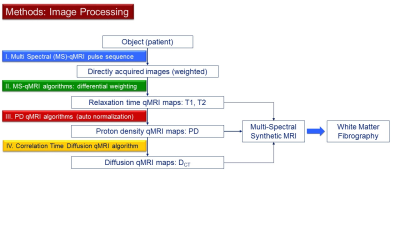 |
 Connectome of the Extremely Preterm Brain at Adolescence and Measures of Cognitive Functioning: Early Experience with White Matter Fibrography (WMF) Connectome of the Extremely Preterm Brain at Adolescence and Measures of Cognitive Functioning: Early Experience with White Matter Fibrography (WMF)
Hernan Jara, Osamu Sakai, Stephan Anderson, Timothy Heeren, Karl Kuban, Thomas O'Shea
Purpose: To analyze the fiber bundle architecture via white matter connectomes of extremely preterm (EP) born adolescents generated by Synthetic-MRI based white matter fibrography, and to study associations with summary measures of intelligence quotient (IQ) and executive function (EF). Methods: Eleven EP adolescents were scanned the tri-turbo spin echo pulse sequence, which is the concatenation of dual-echo TSE and single-echo TSE pulse sequences, both acquired with same geometry and scanner settings. Results: Connectome were successfully created for all subjects. Conclusion: White matter fibrography is a direct and reliable method for generating whole-brain white matter connectomes in adolescents born EP, and appears to have clinical relevance.
|
14:45
|
0848.
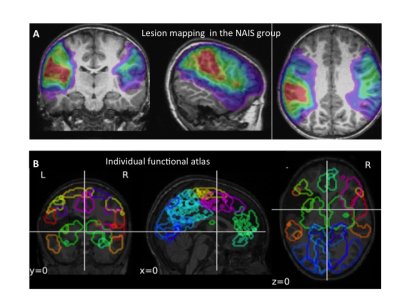 |
 Long term Brain Functional Connectivity changes after Neonatal Arterial Ischemic Stroke (NAIS): A resting state fMRI study Long term Brain Functional Connectivity changes after Neonatal Arterial Ischemic Stroke (NAIS): A resting state fMRI study
Lucie Hertz-Pannier, Dhaif Bekha, Victor Delattre, David Germanaud, Laure Drutel, Edouard Duchesnay, Marion Noulhiane, Cyrille Renaud, Manoelle Kossorotoff, Mickael Dinomais, Stephane Chabrier, Sylvie N Guyen The Tich
Resting state fMRI enables the study of plastic inter- and intra- hemispheric connectivity changes after early brain lesions. We studied 38 7yo children having suffered an arterial ischemic stroke in the neonatal period (NAIS) and 29 age-matched controls, with rs-fMRI, and language fMRI. Preprocessing took into account various sources of spurious signals (motion, lesion, interdependency of correlation measures, etc…). Tangent metric appeared the most accurate to classify groups of subjects and highlighted mostly a reduced inter-hemispheric connectivity in the auditory, language, and attentional networks, especially in patients with atypical clinical or fMRI language profiles, but with little evidence for intra-hemispheric changes.
|
14:57
 |
0849.
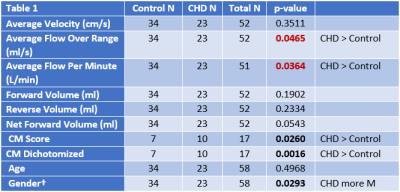 |
 Macroscopic Hyperdynamic CSF and Ciliary Motion Dysfunction Predict Executive Dysfunction in Children and Adolescents with Congenital Heart Disease Macroscopic Hyperdynamic CSF and Ciliary Motion Dysfunction Predict Executive Dysfunction in Children and Adolescents with Congenital Heart Disease
Vincent Lee, Rebecca Hartog, William Reynolds, Nancy Beluk, Omar Khalifa, Daryaneh Badaly, Maliha Zahid, Rafael Ceschin, Cecilia Lo, Ashok Panigrahy
An important role for cilia in congenital heart disease (CHD) pathogenesis has been seen in mouse model of CHD. There is a high prevalence of motile respiratory cilia dysfunction in human CHD patients. In this study, we investigate whether abnormal respiratory cilia motion in preadolescent CHD patients may be correlated with alterations in macroscopic CSF flow dynamics and poor executive cognitive function using phase contrast imaging. We show disturbance of CSF flow dynamics is significantly correlated with neurocognitive impairment in CHD subjects.
|
15:09
|
0850.
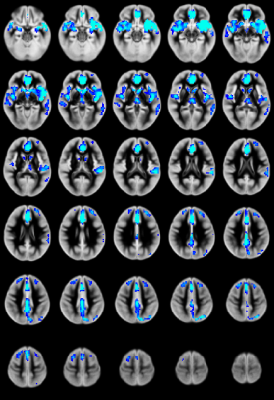 |
 Reduced Nasal Nitric Oxide Predicts Mis-matched Alterations in Regional Cerebral Perfusion and Functional Brain Connectivity in Older Children with Congenital Heart Disease Reduced Nasal Nitric Oxide Predicts Mis-matched Alterations in Regional Cerebral Perfusion and Functional Brain Connectivity in Older Children with Congenital Heart Disease
Vincent Schmithorst, Philip Adams, Vince Lee, Cecilia Lo, Ashok Panigrahy
We investigate the relationship between congenital heart disease (CHD), regional CBF, functional connectivity, and nasal nitric oxide (nNO) levels in older children. Low nNO is associated with poor cardiac function in CHD although the precise mechanism is unknown. Results show that, in CHD patients, reduced nNO is associated with reduced regional CBF in the salience and default mode networks as well as reduced segregation globally (modularity) and regionally (frontally, parietally, and subcortically); these relationships are not present in normal controls. These results suggest intrinsic brain deficits (more so than impaired substrate delivery) may underlie neurocognitive deficits in CHD patients.
|
15:21
|
0851.
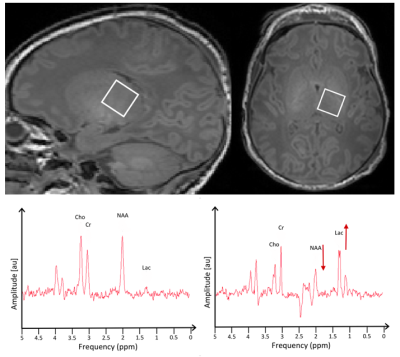 |
 Thalamic Lac/NAA threshold of 0.39 on proton MRS predicts outcome following therapeutic hypothermia in neonatal hypoxic ischemic encephalopathy Thalamic Lac/NAA threshold of 0.39 on proton MRS predicts outcome following therapeutic hypothermia in neonatal hypoxic ischemic encephalopathy
Subhabrata Mitra, Giles Kendal, Cristina Uria-Avellanal, Alan Bainbridge, Magdalena Sokolska, David Price, Xavier Golay, Nikki Robertson
Perinatal hypoxic ischemic brain injury remains a significant cause of neonatal morbidity and mortality. Accurate prediction of neurodevelopmental outcome following HIE is important for parental counselling and directing care towards optimised treatments. Proton MRS derived thalamic Lactate/N-acetylaspartate (Lac/NAA) peak area ratio at 1.5T was a robust MR outcome biomarker in
the pre-cooling era; a cut off Lac/NAA of 0.29 accurately predicted outcome. The aim of this work is to identify the cut off threshold of thalamic Lac/NAA at 3T in the cooling era for outcome prediction.
|
15:33
|
0852.
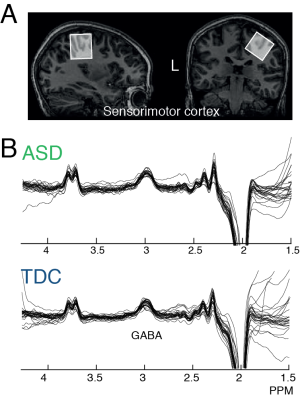 |
 GABA levels in children with Autism and typically developing children differentially relate to social gesture performance GABA levels in children with Autism and typically developing children differentially relate to social gesture performance
Nicolaas Puts, Ashley Harris, Georg Oeltzschner, Mark Mikkelsen, Stewart Mostofsky, Richard Edden
Children with Autism (ASD) often suffer from motor abnormalities and the main inhibitory neurotransmitter GABA has been linked to ASD. We measure GABA in the primary sensorimotor cortex using MRS and measure praxis (social gesturing) in children with ASD and healthy children (TDC). We show that GABA is differentially related to social gestures in children with and without ASD. This suggests a complex relation between inhibition and gesture function. Reduced GABA levels may impair the performance of gestures with a communicative purpose, contributing to autistic phenotypes. Understanding the GABA system in ASD is important for developing patient-specific treatment in ASD.
|
|













